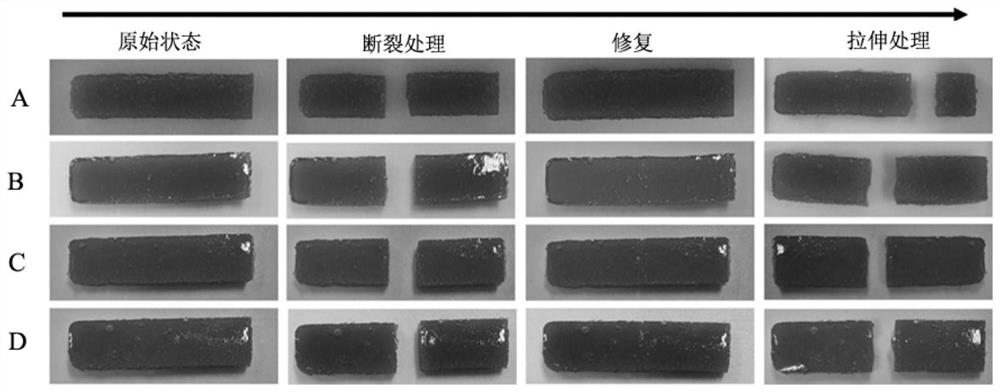A method for temporary repair of kinetically stable polymer materials based on enzymatic reaction regulation
A polymer material and enzymatic reaction technology, applied in the field of temporary repair of polymer materials, can solve the problems of lack of self-healing ability and restrictions on the practical application of self-healing materials
- Summary
- Abstract
- Description
- Claims
- Application Information
AI Technical Summary
Problems solved by technology
Method used
Image
Examples
Embodiment 1
[0041] by Co 3+ -4A-PEG-His, glucose oxidase to form a hydrogel, wherein, the Co in the hydrogel 3+ The concentration of 4A-PEG-His is 13.3mM, the concentration of 4A-PEG-His is 10mM, and the concentration of glucose oxidase is 0.4mg / mL; the ascorbic acid solution containing glucose is used as the repair solution, wherein the concentration of ascorbic acid in the repair solution is 4mM, glucose The concentration is 53.2mM.
[0042] Co in the above hydrogel 3+ Form a complex with redox response with 4A-PEG-His, 4A-PEG-His and Co 3+ After coordination, it can form a hydrogel with high mechanical strength and high dynamic stability, but it does not have self-healing ability. 4A-PEG-His and Co 2+ When coordinated, a hydrogel with self-healing ability can be formed. When the above-mentioned hydrogel breaks due to external force, apply the above-mentioned repair solution on the fracture surface, and ascorbic acid will reduce the Co in the hydrogel 3+ Rapid reduction to Co 2+ ,...
Embodiment 2
[0046] The hydrogel is composed of urease, PAM-co-PDAAM and ADH, wherein the concentration of urease in the hydrogel is 3mg / mL, the concentration of PAM-co-PDAAM is 270mg / mL, and the concentration of ADH is 28mg / mL; The acidic buffer solution containing urea is the repair solution, wherein the pH of the repair solution is 4, the concentration of urea in the repair solution is 80mg / mL, and the acid buffer solution is 1M citric acid / sodium citrate buffer.
[0047] In the above hydrogel, PAM-co-PDAAM forms a hydrazone bond with adipate dihydrazide (ADH), and the hydrazone bond is kinetically stable above pH 7 and reversible at pH 3-5. When the above-mentioned hydrogel is broken due to external force, the above-mentioned repair solution is applied on the fracture surface. The acidic buffer first quickly reduces the pH of the fracture surface to activate the hydrazone bond. After the hydrazone bond is activated, the process of breaking and re-bonding the hydrazone bond can guide the...
Embodiment 3
[0051] Glucose oxidase, PEO-PAA-CaCO 3 Composition coating material, wherein, the concentration of glucose oxidase in the coating material is 0.4mg / mL, the concentration of PEO is 4mg / mL, the concentration of PAA is 4mg / mL, CaCO 3 The concentration of the solution is 0.005mM; the neutral buffer containing glucose is used as the repair solution, wherein the concentration of glucose in the repair solution is 35mM, and the neutral buffer is 0.1M phosphate buffer.
[0052] Among the above-mentioned coating materials, polyethylene oxide and polyacrylamide can form a pH-responsive coating material through the interaction of hydrogen bonds. The hydrogen bonds are weakened at high pH and re-formed at low pH. When the above-mentioned coating material is damaged, drop the above-mentioned repair solution on the damaged part. First, the neutral buffer will weaken the hydrogen bond force between PEO and PAA, thereby improving the fluidity of the polymer and promoting the connection with th...
PUM
 Login to View More
Login to View More Abstract
Description
Claims
Application Information
 Login to View More
Login to View More - R&D
- Intellectual Property
- Life Sciences
- Materials
- Tech Scout
- Unparalleled Data Quality
- Higher Quality Content
- 60% Fewer Hallucinations
Browse by: Latest US Patents, China's latest patents, Technical Efficacy Thesaurus, Application Domain, Technology Topic, Popular Technical Reports.
© 2025 PatSnap. All rights reserved.Legal|Privacy policy|Modern Slavery Act Transparency Statement|Sitemap|About US| Contact US: help@patsnap.com


